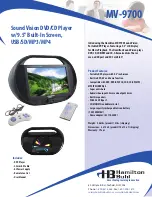
today, when you pick them up you should be able to navigate through its menu system without too much trouble that is,
if the buttons have a logical layout and operation. In more than 3 pairs of hands the AU822 proved to be a challenge. The
buttons do not operate in the way that you would expect them to and especially since they’re placed in a way similar to
many other controller styles it makes it a little annoying. To switch the device on you press and hold on the play button
for about 1.5 seconds after which you are presented with a rather goofy animated ‘Welcome’ screen with flowers in the
background. Another downside is noticed upon switching the device on and that’s its low resolution screen in comparison
to the Nano’s. Each feature can be selected by using the up and down buttons and they are represented with large low
resolution animated icons to help you distinguish each selection.
Unfortunately things get very annoying and awkward when you’re in playback mode. As mentioned earlier, the buttons do
not work in the way that you would think is common sense. Pressing the left button will make the volume icon flash on
the screen to let you know that you’re in volume level adjustment mode. Why you can’t just adjust the volume any easier
is beyond us. It’s the feature that you would expect to access most frequently with immediacy. The up and down buttons
allow you to navigate between different tracks. Keep in mind though, if you have any voice recordings they will also show
up here for your inconvenience. As far as we could make out there is no feature to create and save play lists, however,
you can create folders and put tracks into those folders for example copying Track1.mp3 to a folder name Artist. This can
only be done when the device is plugged into your computer’s USB port upon which it can be used as a standard mass
storage device.
It takes some time getting used to navigating around the AU822’s cumbersome button functions but once you do you
realize how much more this device offers than what its inspiration (the Nano) does.
Voice recording
This feature works rather well. All voice clips are recorded in WAV format and thanks to the AU822’s sensitive built
microphone it allows you to record conversations discreetly too if that’s what you have in mind. The screen offers plenty
of useful information when in record mode such as time elapsed and total recording time available.
In our tests we found that the quality of the voice recordings were fair. Voices sound a little muffled and subdued this is
due to the 32Khz recording nonetheless they were certainly picked up by the microphone and recorded conversations
were comprehensible.
FM Radio
Certainly the ability to tune into your local radio station sound pretty neat no? Thanks to this feature you can also use the
AU822 as a radio player and we have to admit it does the job well. Audio quality is exceptional and the tuning into
different stations is made very easy. You simply press the up and down buttons to fine tune into your station or
alternatively you can press and hold on the buttons and the tuner will auto scan to the next station. The AU822 also has
the ability to record from the radio as well. Each recording is saved in WAV format and you have the option of
or ‘Long Rec’ with the latter being of lesser quality but allowing for longer recordings. Once tuned into your station you
can save the station by pressing the mode buttons and selecting save. Each save you make will save the station onto a
new separate channel. Channels can be toggled by pressing the play/pause button and the switch is instant.
Overall the radio functionality is excellent.
Video player
The video playing capabilities of the AU822 provide it another trump card when pitting it against similar players in the
same camp. Playback of video is actually quite good, however, there is a significant amount of image ghosting seen on
Page 4 of 6
Tech Gear - Hardware Reviews, software reviews, games reviews
10/18/2006
http://tech-gear.org/reviews/mp3/au822/index.htm
























